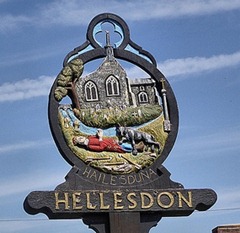KING EDMUND – of Bury St Edmunds fame - died in 869 at the hands of the Danes. And the legend tells us that he was martyred at a place called 'Hægelisdun'. But where’s that? It could be Hellesdon and, as this image on the sign makes clear, the Norwich village/suburb is happy to claim him. That’s St Edmund lying motionless on the floor. The animal is a wolf. The legend says that St Edmund’s severed head was found between the paws of an uncharacteristically meek wolf, so they’ve spared us the full gruesome horror in this 20th century version.
But was it really Hellesdon? The excellent hiddenea website, makes clear that Hellesdon is one of only five possible locations. So Hoxne, Hollesley etc will all need a mention too.
I struggle to summarise these saintly tales. I had to write the Legend of Lodbrog (Reedham) for the Wherryman’s Way book while St Walstan will come under Taverham in this one. The better the miracle the better the story to medieval eyes. The better the miracle the more ridiculous it seems to modern sensibilities. Try this from wikipedia for example:
“His severed head was thrown into the wood. Day and night as Edmund's followers went seeking, calling out "Where are you, friend?" the head would answer, "Here, here, here," until at last, "a great wonder", they found Edmund's head in the possession of a grey wolf, clasped between its paws. "They were astonished at the wolf's guardianship".The wolf, sent by God to protect the head from the animals of the forest, was starving but did not eat the head for all the days it was lost. After recovering the head, the villagers marched back to the kingdom, praising God and the wolf that served him. The wolf walked beside them as if tame all the way to the town, after which it turned around and vanished into the forest.”
So what do I do? Tell it straight as though I believe every word? Ladle on the irony and risk looking smug? But then has anyone every believed it? After all, towns battled for the right to be connected to saints for the money the pilgrims brought to the local economy. At the end of the day it all seems a bit Loch Ness Monster.

No comments:
Post a Comment